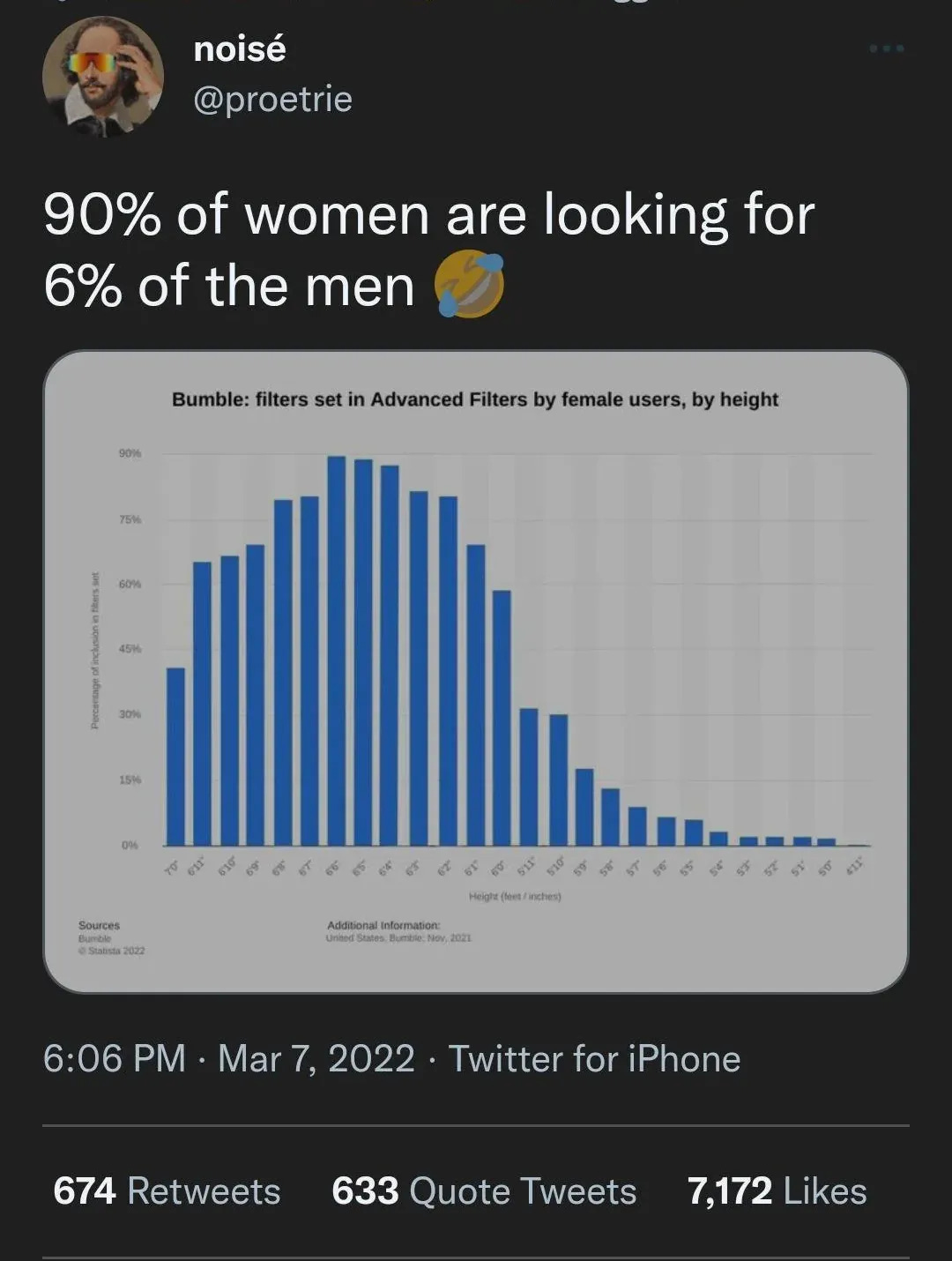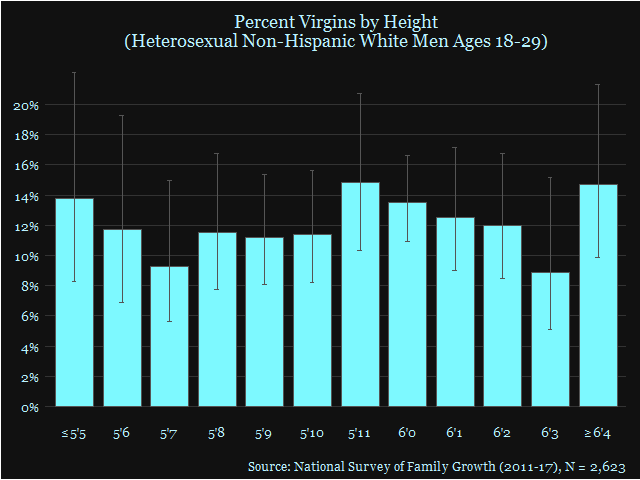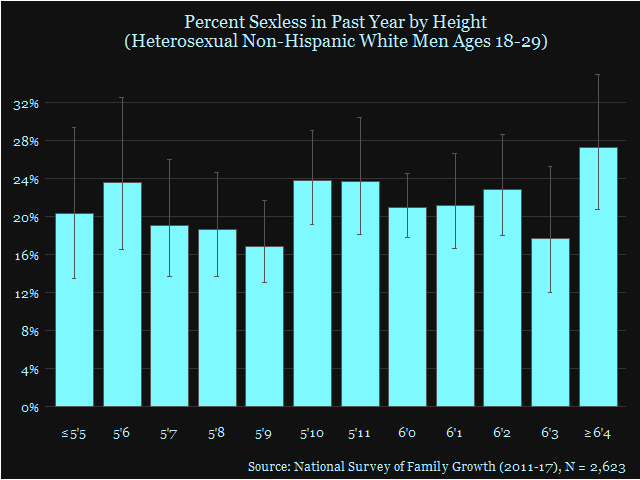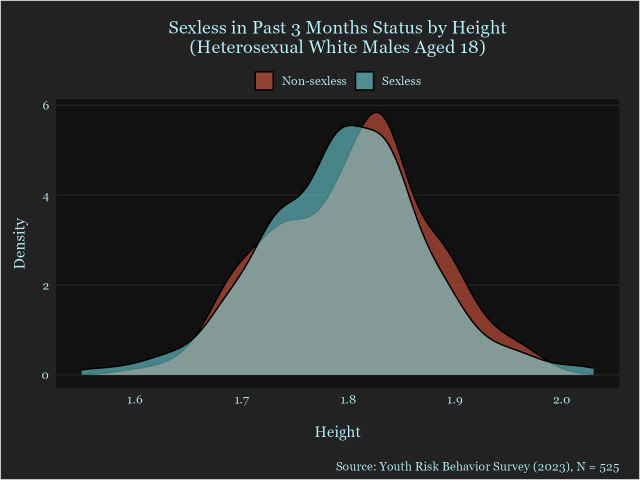The Bumble Height Filter and Height's Effect on Celibacy
The infamous Bumble graph is probably fake news, and there is hope for manlets
Two traits dominate the discourse around ‘involuntary celibacy’ within the incel or ‘black pill’ community, and increasingly elsewhere: facial attractiveness and height. According to this worldview, men’s place on these distributions basically entirely dictates whether or not they are allowed to have sex, and if you are below average1 in either of them, it’s ‘over’. Those who don’t accept this are accused of being ‘blue pilled’ and ‘coping’, insinuating that the only conceivable reasons for objecting to it are either blissful ignorance fostered by systematic gaslighting, or that it’s a ‘dark truth’ which you lack the mental fortitude to confront.
Today we will be taking a look at the second trait to see if it’s truly as decisive as people think.
While ragebait TikTok clips and likely fabricated height filter graphs (covered below) may give an exaggerated picture, it does seem to be the case that women generally express a preference for taller men. It should be said that these stated preferences exhibit relatively weak predictive validity when it comes to actual selections during speed-dating events2, but nonetheless tall men are generally preferred over short men—with a greater penalty for shortness than advantage for tallness. Setting aside the ‘Chadopoly’ meme, if height is a component of men’s desirability, and more desirable people tend to pair off sooner, then it stands to reason that we might find a disproportionate number of manlets within the celibate population.
The Bumble graph: fake news?
Let’s first get this out of the way. A widely circulated graph purports to show height filters set by female Bumble users. As we see, nearly 70% of women filter out men below 6 feet right off the bat, fewer than 10% are willing to entertain men 5’7 or under, and a 7-foot lanklet is preferred over a 5’11 ‘man’. A brutal height pill, who could deny it?
If history has taught us anything though, the mere fact that this is a viral graph should give us pause.
You’ll notice that it cites Statista as a ‘source’ (which is kind of like citing Wikipedia as a source, since all Statista does is compile data from other sources), yet if you search this site using keywords such as ‘bumble’, ‘height’, ‘filter’, curiously it is nowhere to be seen.
A redditor reached out to their Twitter account for clarification, and here’s how they responded:
They deny any connection to it, and assure us that such information wouldn’t be shared publicly. I guess it must have been leaked by an insider who couldn’t resist dropping this black pill truth bomb.
Is it over for manlets?
Examining NSFG survey data for 18-29 Non-Hispanic White men3, the percentage of virgins across different heights ranges from 8–15%, with no discernible pattern emerging.
Ditto for sexlessness in the past year.
The table below compares the mean heights between men who were or weren’t virgins or sexless4 in five representative datasets56. Cohen’s d values ranged from –.06 to .13 (1 cm)—with the exception of the GSS which had a low sample size—and none of these differences reached statistical significance.
Using the most recent available data, the height distributions between sexless and sexually active men show minimal differences. It’s clear we’re a long way from any kind of ‘6 ft or bust’ scenario.
Using logistic regression models with virginity and sexlessness as the dependent variables and including ethnicity, education, and age as covariates, significant effects were observed only among the 18 year olds of the YRBS78, with 1 SD increase in height corresponding to a 0.15–0.2 increase in the log-odds of virginity and sexlessness9. With a 50% virginity rate, this would mean the probability decreases by about 4–5%.
Conclusion
There are no shortage of misleading graphs being spread around out there, but at least until now, it’s not often that they've been outright fabricated. This sets a worrying precedent; graphs don't even have to be based on any real data and they will still go viral with virtually nobody stopping to question their authenticity as long as it looks ‘official’ enough. It’s not surprising that many were ready to accept any negative information regarding dating apps given how much frustration they generate, but if the height pill reflects a brutal truth, then it shouldn't be necessary to fabricate graphs.
Assuming for argument’s sake that it’s genuine, it’s still not necessarily worth making a big fuss over. It’s worth considering for instance the selection bias whereby women who go out of their way to set a filter are those with more stringent preferences. Also, the skewed gander ratio on dating apps incentivizes women to apply extra selectivity, and this would be a convenient way to narrow the pool down to a more manageable size. They can’t all get a 6’2 guy though, and contrary to popular myth, we do not inhabit a ‘de facto polygynous’ society.
Given that height appears to have at most a minimal influence on men's total number of sexual encounters, relationship status, and fertility, it’s not entirely surprising that its predictive power for celibacy in particular is similarly limited. As mentioned in the previous article, a study using the large UK biobank dataset found no significant effect of polygenic scores for height on virginity late into life. It might be the case that it’s ultimately more of a limiting factor at amusement park rides.
For those who’d challenge the veracity of the sex data due to its self-reported nature, I’m not about to open the whole ‘are self-reported sex partners reliable’ can of worms, but I’d simply ask: why would the same thing not apply to tall men? If height had an effect on celibacy even approaching the level asserted by black pillers, and celibate men had a general tendency to understate their celibacy on surveys, we would expect to see a substantially lower reported celibacy rate among tall men even with substantial misreporting, otherwise one would have to make the seemingly arbitrary assumption that a substantially higher proportion of short celibate men lie about it than tall celibate men.
That said, we can say with relative confidence is that there are probably at least a few men who are currently celibate but who would not be if height preferences disappeared. It’d arguably be a strange anomaly for this to be such a widespread perception and subject of debate, frustration, and memes online were it the case that height played no meaningful role in men’s success with women. On the other hand, it’s hardly the first phenomenon to be blown out of proportion relative to what the numbers warrant. As mentioned in the other articles though, this outcome data may not tell the full story, there are other factors worth considering that are often brought up in response to this kind of data—such as partner desirability—but it does tell us that shortness is by no means the ‘death sentence’ many make it out to be.
One might be tempted to say that manlets can rejoice, but whatever issues were getting in the way before won’t suddenly go away now. Incels will often ridicule the suggestion that psychological factors may be holding them back, for instance sarcastically paraphrasing: ‘height doesn’t matter, it’s your personality bro’, and coining clever terms like ‘heightfidence’. They also present themselves as objective data lovers interested only in the cold hard facts. What the data quite consistently demonstrates however is that physical characteristics have at best small effects on dating/sexual outcomes, and psychological characteristics and behaviour actually have greater predictive power. What could be described as ‘morphological reductionism’ is an intriguing phenomenon, and its psychological underpinnings might warrant further exploration.
This is a charitable interpretation; usually it’ll be said that average isn’t enough anymore.
Women’s estimated likelihood of ‘yessing’ a man outside their preferred height range went from 32.2% to 25.4%, though for those 5 inches below it (almost 2 SDs), it dropped to about 15%.
Including all ethnicities could confound the results if both height and sexual behaviour vary by ethnicity.
In the past year for all datasets except for the YRBS where the question referred to the past 3 months.
Surveys: National Longitudinal Study of Adolescent to Adult Health, General Social Survey, National Health and Nutrition Examination Survey, National Survey of Family Growth, and the Youth Risk Behavior Survey.
Height was self-reported in all but NHANES; however, while there is a slight tendency towards overestimation, self-reported height correlates almost perfectly with actual height.
The category was actually '18+', but since these were high schoolers it's unlikely many of them were above the age of 18.
Males on the older end of 18 may be more likely to have reached their full height (and had sex); however, by 18, 98% have done so, so this is unlikely to meaningfully confound the results.
Interestingly, there was also a significant quadratic effect, such that at a certain point this effect reversed.











Short men have advantages in health and longevity:
https://pmc.ncbi.nlm.nih.gov/articles/PMC1071721/
High testosterone during puberty can stunt growth:
https://pubmed.ncbi.nlm.nih.gov/173825/
Women are more attracted to taller men. However, shorter men may have psychological or physiological advantages over taller men.
The #1 determinant of body count is effort. A tall man has a much wider pool of available females. However, even if a shorter man has access to only 10% as many females, that shorter man need only apply greater effort than the tall man in order to compensate for the smaller pool of available females.
Promiscuity is likely heritable, and I would further hypothesize that shorter people tend to be more promiscuous (less sexually selective) than taller people, in line with R-K selection theory (more development, more parental investment, less promiscuity).
Two tall people who marry will tend to be, on average, more sexually selective than two short people who marry. Hypergamy and selectivity is inversely correlated with promiscuity. Short men are, on average, the result of low-hypergamy, low-selectivity pairings, which tends to cluster with promiscuous traits.
Extraversion is associated with shorter height:
https://pubmed.ncbi.nlm.nih.gov/23713700/
As a man, if you are extraverted, funny, athletic, promiscuous, and spend time and effort meeting women, you will have more sexual success than a shy, humorless, lanky, depressed tall guy who is a loner and puts no effort into meeting women. Short men compensate for their lack of attractiveness with increased effort.
Sure short men can get women , but what’s the quality ? That’s the interesting question . Maybe they can get women because they lower their standards.